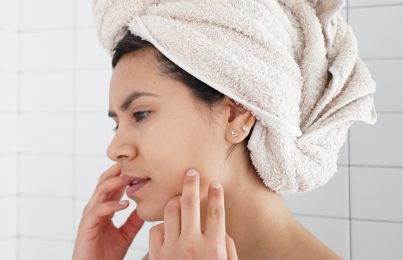While your skin type should always be the main factor in determining which products and ingredients you use, another factor to take into consideration is your skin tone. While people with very fair skin tones are more likely to experience concerns such as sensitivity, redness, and broken capillaries, common concerns for people with deeper skin tones include hyperpigmentation, dark marks, dehydration, and raised scars. In this post, I talk with two amazing skin experts, as well as share my own expertise working as a hands-on esthetician, about the best ways to tackle these common concerns.
Meet the Experts
Dr. Uju Rapu, M.D.
Dr. Uju Rapu is a medical doctor who specializes in dermatology and esthetic medicine. She is the founder of Belfiore Aesthetics in Lagos, Nigeria. Dr. Rapu and her team specialize in non-surgical, minimally invasive cosmetic and anti-aging procedures.
Dija Ayodele, L.E.
Dija Ayodele is a licensed esthetician and founder of West Room Aesthetics in London, England. Dija also founded the multiple award-winning Black Skin Directory, which connects people of color to skincare brands and expert professionals experienced in managing darker skin tones.
What Are the Most Common Concerns for Skin of Color?
According to both Dija and Dr. Rapu, these are the most common concerns they see in patients or clients with skin of color:
- Hyperpigmentation
- Dehydration
- Keloid scarring
- Dermatosis papulosa nigra
Hyperpigmentation
Post-inflammatory hyperpigmentation (caused by acne or any other trauma to the skin) typically affects those with darker skin tones more. This is because melanocytes, the cells that produce pigment, are already more active in darker skin tones, so when the skin is injured these cells produce an excess of melanin that causes dark marks to form.
“Skin of color is more prone to hyperpigmentation conditions because of the melanin content in our skin,” says Dr. Rapu. “Hyperpigmentation is most commonly seen after trauma to the skin or an inflammatory reaction, which can occur secondary to untreated acne, picking at the skin, or certain cosmetic treatments performed incorrectly!”
To treat hyperpigmentation, here’s what I recommend:
- Use a gentle acid exfoliant for your skin type. This will help loosen damaged, discolored cells from the skin’s surface.
- Use a physical exfoliant with non-plastic, rounded beads. Gently massaging a facial scrub over affected areas twice a week will physically lift off the damaged cells that have been loosened up by your acid exfoliant. (While facials scrubs have become less popular these past few years with acid exfoliants increasing in popularity, here’s why you really need to use a scrub.)
- Use tyrosinase inhibitors. Look for products with ingredients that will block tyrosinase (the enzyme responsible for controlling the production of melanin). This will help interrupt the signals being sent to melanocytes telling them to remain active. These ingredients include azelaic acid, kojic acid, arbutin, licorice extract, and vitamin C.
- Get serious about sun protection. Any UV light your skin is exposed to (even on cloudy days) will activate melanin cells. Since hyperpigmentation is an indication of overactive melanin cells, UV light will aggravate this and make excess pigment linger. You absolutely MUST use sunscreen every single day. I also recommend wearing a hat and seeking shade when out during hours of peak sun. And yes, all skin tones need sunscreen.
- Avoid picking at your skin. Easier said than done, I know. But preventing hyperpigmentation in the first place whenever possible is definitely preferable.
While having a deeper skin tone doesn’t necessarily mean treating hyperpigmentation differently than other skin tones, it often means you have to be more diligent about both treatment and prevention. Learn more about how to fade dark marks and acne scars.
Dehydration
According to Dija, dehydration can be a concern due to increased transepidermal water loss in darker skin tones.
One of the best ways to prevent this is to stay away from products with harsh ingredients that will irritate your skin and strip it of its natural oils. This includes sulfates like SLS (sulfates), high amounts of synthetic fragrance, and drying alcohols such as denatured alcohol or SD alcohol 40. Be wary of products targeted toward oily skin since these are often the worst offenders when it comes to stripping your skin.
It’s also crucial that you focus on keeping your skin’s natural moisture barrier healthy and intact. Here’s how.
Keloid Scarring
“Keloids are more common in skin of color,” says Dr. Rapu. “They tend to occur as a response to trauma. The skin over-heals with excessive collagen production outside the boundary of the initial wound. Keloids have a significant genetic component and tend to run in families. Most people by their adult years would know if they are prone to keloids, either from insect bites, ear piercings, or other wounds. If you are prone to keloids, it is best to completely avoid unnecessary procedures to the skin. This includes tattooing, certain piercings, and unnecessary cosmetic surgery. Keloids are less common (but still possible) on the face and, as such, it is still best to approach any facial injectable treatment with high caution.”
In most cases, keloids can’t be fully removed. They can sometimes be minimized using treatments like intralesional steroid injections, pressure banding, laser treatments, or surgery (though surgery has the potential to actually make keloids worse).
Dermatosis Papulosa Nigra (DPN)
DPN refers to small, smooth, black or dark brown papules on the face and neck (you can see what they look like here). They can lie flat against the skin or become raised, at which point they start to resemble skin tags. Women tend to be more affected by them than men, and you’re also more likely to develop DPN if you have a family history.
While DPN is harmless, you may prefer to get the papules removed for esthetic reasons. The challenge here is that removal can easily trigger a post-inflammatory response and create hyperpigmentation if not done carefully. Here’s what Dija and Dr. Rapu suggest to decrease the risk of this happening.
“Ensure that the client is already using tyrosinase inhibitors in their regime to suppress and control melanin,” Dija says. “Additionally, accompanying the removal with treatments such as LED will stimulate the healing mechanisms of the skin to prevent hyperpigmentation. There are times when hyperpigmentation will be unavoidable, but having a good, robust skincare regime in place will help with controlling any pigmentation issues that arise.”
“Skin tags and growths should not be removed without an accurate diagnosis by a dermatologist,” Dr. Rapu adds. “The deeper the growth in the skin, the higher the risk of pigmentation changes. It is important to be aware of these risks before having such procedures done. Esthetic dermatologists with experience in skin of color will oftentimes ‘prep’ the area with a depigmenting product and will suggest a high protection sunscreen for a few weeks before performing the treatment. This is necessary to reduce melanocyte activity in the area prior to treatment. Post-treatment, sun avoidance and use of a high SPF sunscreen are just as important for uncomplicated healing.”
Learn more about identifying and helping with bumps on the skin.
Are Exfoliating Acids Safe to Use on Skin of Color?
Both Dija and Dr. Rapu agree that using exfoliating acids on skin of color is perfectly safe. Regardless of skin tone, it’s just about using them responsibly. The key, they say, is beginning with lower concentrations, starting slow then working your way up. Keep in mind that
“It’s an incorrect belief and a myth that acids can’t be used on skin of color,” Dija says. “Acid-based products are perfectly fine for Black skin, and which one you use is really down to preference.”
“There’s a lot to be said about how people are using the acid as well,” Dija adds. “On dark skin, you may want to patch test before you use an acid. Perhaps start with an acid that has larger molecules, like gluconolactone, for example, and slowly work your way up to AHAs like mandelic and glycolic. Don’t be heavy-handed, there isn’t any benefit to using an acid every day, twice a day.”
“When it comes to acids, I advise my patients according to the specific needs of their skin,” says Dr. Rapu. I like mandelic, salicylic, and azelaic acids for acne-prone skin; glycolic, azelaic, and phytic acids for hyperpigmented skin; and lactic acid for dry, dull, and aging skin.”
“For sensitive skin, I prefer mandelic acid, especially when it comes to medical-grade peels,” Dr. Rapu says. “Mandelic acid has larger molecules, which penetrate the skin slowly and more uniformly, causing less irritation.”
“With home care,” she adds, “I would typically advise starting two nights a week for the first two to three weeks and gradually increasing frequency until you’re seeing the results you want. Again, sunscreen use the following day is mandatory!”
Sunscreen
When it comes to caring for skin of color, one pervasive myth I continue to hear is that if you have a deeper skin tone, you don’t need to wear sunscreen. This is simply not true, and as Dija explains, this myth can become dangerous.
“Skin of color needs sun protection, period,” says Dija. “We may not burn as easily as white skin, but it is possible to get a sunburn, which can potentially lead to skin cancer. Even with the presence of melanin, darker skin tones can and DO experience incidences of skin cancer, which can have poor outcomes as evidence shows it’s normally caught much later than on white skin.”
Regardless of your skin tone, sunscreen is also the number one most effective ingredient when it comes to preventing visible signs of aging such as sun spots, fine lines, and wrinkles. It’s also your best weapon against hyperpigmentation since UV rays will stimulate pigment cells and keep them active.
Look for a sunscreen that offers a minimum of SPF 30 protection. Sunscreen works best when applied liberally and often, so it’s important to choose one with a cosmetically elegant formula that you enjoy wearing. Of course, one of the challenges is finding a sunscreen that doesn’t leave a white cast on deeper skin tones. I formulated my Weightless Protection SPF 30 with this in mind and am proud to say it works well on all skin tones. Plus it’s so light for those who don’t want to feel their sunscreen throughout the day.
Watch Dr. Rapu demonstrate proper sunscreen application using Renée Rouleau Weightless Protection SPF 30.
What to Be Mindful of When Seeking Out Skincare Professionals
When getting professional treatments or procedures done, it’s really important to seek out practitioners who make you feel comfortable and understand how to treat skin of color without causing inflammation or trauma that may trigger hyperpigmentation.
Dija suggests the following:
- Go to someone who was recommended to you by a trusted source
- Ask the practitioners about their experience treating skin of color
- Ask to see evidence of their work, such as before-and-afters or case studies
- Ask how many times they’ve performed this specific treatment on skin of color
- Pay attention—do they take the time to educate you and explain how your skin will react to treatment compared to white skin?
- Ask about possible complications you may experience as a result of the treatment and what the plan is should this happen
Learn more about how to find a reputable skincare professional.
So there you have it! While everyone’s skin has the same basic needs, certain concerns are more of a priority if you have a deeper skin tone. I hope this post provides some helpful insights into managing these concerns! Thank you again to Dija Ayodele and Dr. Uju Rapu for their valuable contributions and wonderful information. For more resources on caring for skin of color, be sure to check out Dija’s Black Skin Directory Blog.
These interviews have been edited and condensed.
Celebrity Esthetician & Skincare Expert
As an esthetician trained in cosmetic chemistry, Renée Rouleau has spent 35 years researching skin, educating her audience, and building an award-winning line of products. Her hands-on experience as an esthetician and trusted skin care expert has created a real-world solution — products that are formulated for nine different types of skin so your face will get exactly what it needs to look and feel its best. Trusted by celebrities, editors, bloggers, and skincare obsessives around the globe, her vast real-world knowledge and constant research are why Marie Claire calls her “the most passionate skin practitioner we know.”



